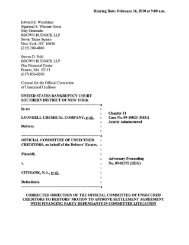Salz Review - Wall Street Journal
Salz Review - Wall Street Journal
Salz Review - Wall Street Journal
You also want an ePaper? Increase the reach of your titles
YUMPU automatically turns print PDFs into web optimized ePapers that Google loves.
187<br />
<strong>Salz</strong> <strong>Review</strong><br />
An Independent <strong>Review</strong> of Barclays’ Business Practices<br />
change is (a problem that needs fixing), how it will be achieved, and how the existing<br />
culture will facilitate or resist the required change. This subtle and important difference is<br />
often misunderstood.<br />
Change is by nature transformational; that is it requires unlearning of beliefs and<br />
behaviours and relearning of new beliefs and behaviours. There are numerous models that<br />
indicate that change typically takes place in stages and that different interventions are<br />
required at the different stages in order for real change to take place.<br />
Lewin (1947) and later Schein and Bennis (1965) describe the change process as one that<br />
takes place in three stages:<br />
― Stage 1: Unfreezing and creating the motivation to change;<br />
― Stage 2: Learning new concepts and new meanings for old concepts, and new<br />
standards for judgment; and<br />
― Stage 3: Internalising new concepts, meanings and standards.<br />
Prochaska and Diclemente 279 (1984) however, recommend a five-stage model of change.<br />
Their model was originally developed as a model of behavioural change for changing<br />
problem behaviours such as cessation of smoking. The model has more recently been<br />
applied to organisational contexts, recognising that cultural change requires significant<br />
shifts in behaviour:<br />
Stage 1: Pre-contemplation (Not Ready) in which people are not ready to change and<br />
typically struggle to believe the benefits of change. Interventions need to be<br />
targeted at educating them of the benefits of change and risks of not changing;<br />
Stage 2: Contemplation (Getting Ready). People can see the benefits of change and<br />
express willingness, but still see the challenge of the change as insurmountable.<br />
Stage 3: Preparation (Ready). People are ready to start taking action. They take small steps,<br />
for example, telling others that they want to change their behaviour and<br />
experimenting with small incremental changes;<br />
Stage 4: Action. People have changed their behaviour and need to work hard to keep<br />
moving ahead. These participants need to learn how to strengthen their<br />
commitments to change and to fight urges to slip back; and<br />
Stage 5: Maintenance (Reinforcing) People have changed their behaviour and must work<br />
on identifying situations that may tempt them to slip back —particularly stressful<br />
situations.<br />
Kotter and Cohen 280 , on the other hand, describe a ten stage process. All models of change<br />
share some common factors. For example, people at different stages of the change process<br />
require different types of interventions; and inappropriately timed interventions can cause<br />
set-backs. Trying to teach new behaviours if the person has not yet decided to change is a<br />
279 James Prochaska and Carlo DiClemente, The Trans-theoretical Approach: Towards a Systematic Eclectic<br />
Framework, 1984.<br />
280 Jan Kotter and Dan Cohen, The Heart of Change, 2002.
















